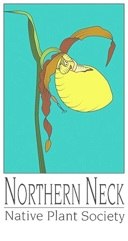The Go Native – Grow Native campaign
seeks to inspire Northern Neck residents and businesses to use native plants in their gardens and protect native vegetation in the landscape.
Native plants provide many ecological benefits. For example, they serve as sources of food (berries, seeds, nectar) and habitat year round for resident and migratory birds. They also provide energy sources and host plants for many pollinators and their larvae, which in turn become bird food. Native plants need less watering, so they assist in water conservation efforts important to maintaining a potable water supply on the Neck. They absorb nutrients and soak up water before it runs off the ground helping to prevent stream pollution. And, they typically require less fertilizer and fewer pesticides than non-native plants, thus reducing the introduction of pollutants to the environment.
A full-color guide entitled Northern Neck Native Plant Guide
with sample garden plans that feature the plants
Northern Neck Native Plant Guide
A comprehensive listing of all the native plants of the Northern Neck
The guide entitled Native Plants of the Northern Neck covers about 300 plants that are indigenous to the Northern Neck and highlights about 100 of these in greater detail. In actuality, there are more than 1,000 species that are native to the Northern Neck.
The accompanying files list all of the plants currently known to be native in one or more of the four counties of the Northern Neck (Lancaster, Northumberland, Richmond and Westmoreland) based on research on the Digital Atlas of the Virginia Flora, found at vaplantatlas.org.
One file is arranged alphabetically by scientific name (genus), the other is arranged alphabetically by common names. Both are interactive files that can be searched. Also, the scientific names are hot links that lead to the Digital Atlas of the Virginia Flora where more information is available concerning habitat and location.
NNK Natives by Common Names.pdf
Some ways to use these files include:
Save the files to develop a personalized inventory of the plants on your property.
Use the habitat information in the Digital Atlas to understand which plants might be suitable candidates for incorporating on your site.
Use the scientific names to search for more information on other informative websites like the Lady Bird Johnson Wildflower Center at www.wildflower.org.
Brochures from the Plant NNK Native Plants Campaign
Go Native – Grow Native campaign activities are increasing both the demand for and supply of Northern Neck native plants. Products include:
New educational signage on native plants in local demonstration gardens.
Native plant identification tags, promotional banners and flags for partner retail establishments to help gardeners identify native plants for their gardens.
Gifts and note cards
The Northern Neck Chapter of the Virginia Native Plant Society (NNNPS) partners with a number of other organizations and businesses in managing the Campaign, which was initiated in 2013. Through the generous support of the Virginia Coastal Zone Management Program, the Campaign has undertaken a number of education and outreach projects promoting the planting of Northern Neck natives. In the fall of 2015, the Campaign published a survey to gather information on the success of the Campaign and potential actions to continue the Campaign. This document summarizes the findings of the survey and implications for future directions:
For more information, send email to gngnplants@gmail.com.


